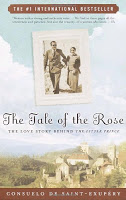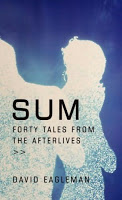 Back in January I wrote two posts about reading challenges: one talking about reading challenges in general, and one in which I (foolishly?) committed myself to taking part in a reading challenge, namely the 2011 To Be Read Challenge. Short recap if you don’t want to click on that link up there—for the TBR Challenge, you promise that sometime in 2011 you’ll read 12 books that have been on your intended reads list for over a year. Over a month has passed since that commitment was made, but I haven’t forgotten about it. There’s a reason these books have been on my radar for over a year without having been read: but finally, that list is one book shorter!
Back in January I wrote two posts about reading challenges: one talking about reading challenges in general, and one in which I (foolishly?) committed myself to taking part in a reading challenge, namely the 2011 To Be Read Challenge. Short recap if you don’t want to click on that link up there—for the TBR Challenge, you promise that sometime in 2011 you’ll read 12 books that have been on your intended reads list for over a year. Over a month has passed since that commitment was made, but I haven’t forgotten about it. There’s a reason these books have been on my radar for over a year without having been read: but finally, that list is one book shorter!
So I thought I would ease myself into this with a short little book I’ve been intrigued with for awhile: The Facts of Winter by Paul … well, we’ll get to that part in a minute.
 A few years back my household joined a book release club through US publisher McSweeney’s in which we paid a subscription fee to receive the next bunch of books they released. It was a cool thing to belong to, every 6 weeks or so a book would show up in the mail: fiction and nonfiction, some the sort of thing we might read anyway and others interesting divergences from our regular reading patterns. The Facts of Winter falls into that latter category—the sort of book I likely wouldn’t have picked up off a store or library shelf and taken home. A slim volume divided into two distinct parts, with a charming back story wrapping it all together.
A few years back my household joined a book release club through US publisher McSweeney’s in which we paid a subscription fee to receive the next bunch of books they released. It was a cool thing to belong to, every 6 weeks or so a book would show up in the mail: fiction and nonfiction, some the sort of thing we might read anyway and others interesting divergences from our regular reading patterns. The Facts of Winter falls into that latter category—the sort of book I likely wouldn’t have picked up off a store or library shelf and taken home. A slim volume divided into two distinct parts, with a charming back story wrapping it all together.
 Back to the author. The cover tells us the book is by Paul Poissel and translated by Paul LaFarge. The introduction to the book tells us “The Facts of Winter is not the best-known of Paul Poissel’s works, but it is certainly the most fantastical. The book is a series of dreams, all dreamed by people in and around Paris during the winter of 1881, which is to say that it is a fictional account of the imaginary lives of people who may or may not be real, and who in any case lived a quarter of a century before the book was written in 1904.” In the first part of The Facts of Winter we are treated to these dreams—side by side in French and in English—followed by an afterword in which the translator tells the story of Poissel and of his own research into the poet and his works.
Back to the author. The cover tells us the book is by Paul Poissel and translated by Paul LaFarge. The introduction to the book tells us “The Facts of Winter is not the best-known of Paul Poissel’s works, but it is certainly the most fantastical. The book is a series of dreams, all dreamed by people in and around Paris during the winter of 1881, which is to say that it is a fictional account of the imaginary lives of people who may or may not be real, and who in any case lived a quarter of a century before the book was written in 1904.” In the first part of The Facts of Winter we are treated to these dreams—side by side in French and in English—followed by an afterword in which the translator tells the story of Poissel and of his own research into the poet and his works.
But is that really what is going on?
I debated whether I would include this next bit in my post—undecided if it constitutes a spoiler or not—but in the end, I decided it was not. Paul Poissel is a fiction, a device the author Paul LaFarge uses to tell his tale. It was LaFarge’s own website that made me decide that revealing the truth of Poissel wasn’t a spoiler: LaFarge gives it away himself. He says that The Facts of Winter was written in New York in the months following 9/11 and says “It is a flight from reality…but also an attempt to answer the question, what do you do with reality when it becomes more than you can bear? You transform it, I thought. You remake it as dream.”
Whether the conceit of the back story intrigues you or not, LaFarge’s book still has much to offer. The first section is perfect winter reading. The dreams are dated, allowing you to follow the progress of the season, much as we all do in real life. The dreams are not the sort of reading that takes you on a journey from A to B. There is no real plot or character development. They read more like a series of curious vignettes in which the author manages to give a pitch-perfect glimpse into the quirky and disjointed realities that happen in our sleeping minds. They were puzzling yet relaxing to read.
The second section of the book reads more like a biography, yet manages to maintain the sense of whimsy established in the dream half. Both the author and subject are present in the biography section, parts of it are the author’s reflections on the work he is doing, others give us insight into the life of Poissel. For me the halves work both in isolation, and as a complete work. I could see some people reading only one section or the other, but the work is most charming in its entirety.

 One book that came to mind a number of times while reading the dream section of The Facts of Winter was David Eaglemen’s Sum: 40 tales from the afterlives, which is also a series of short thoughtful vignettes (these on what happens to us after we have died). The second half of The Facts of Winter would appeal to those who have an interest in author biographies, or in the culture of France: the sort of folks who might find a book like The Tale of the Rose: the love story behind The Little Prince by Consuelo de Saint-Exupery (the wife of the author of the Little Prince). And actually, now that I think of it, Saint-Exupery’s The Little Prince itself might make a good companion piece for The Facts of Winter: similarly charming and childlike yet mysterious and profound.
One book that came to mind a number of times while reading the dream section of The Facts of Winter was David Eaglemen’s Sum: 40 tales from the afterlives, which is also a series of short thoughtful vignettes (these on what happens to us after we have died). The second half of The Facts of Winter would appeal to those who have an interest in author biographies, or in the culture of France: the sort of folks who might find a book like The Tale of the Rose: the love story behind The Little Prince by Consuelo de Saint-Exupery (the wife of the author of the Little Prince). And actually, now that I think of it, Saint-Exupery’s The Little Prince itself might make a good companion piece for The Facts of Winter: similarly charming and childlike yet mysterious and profound.



